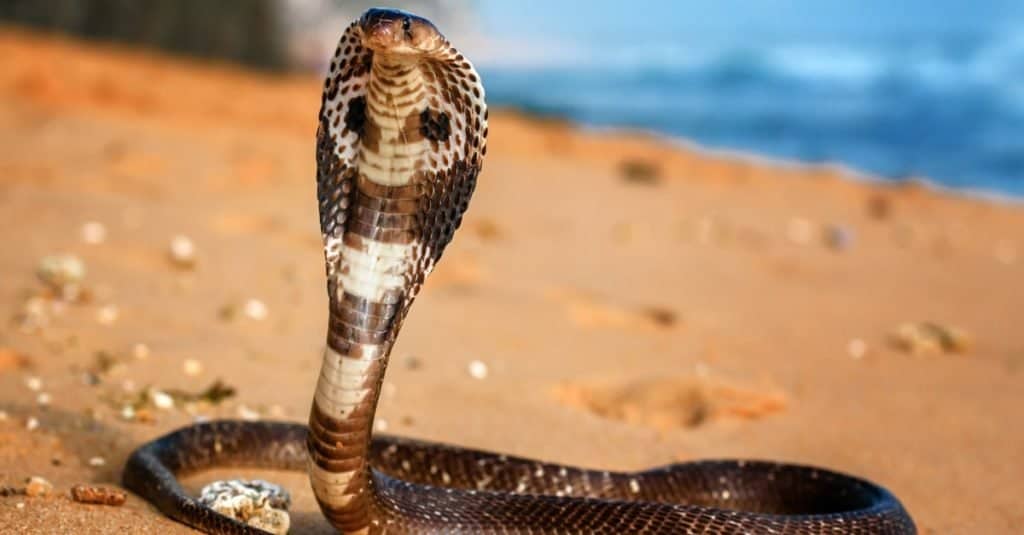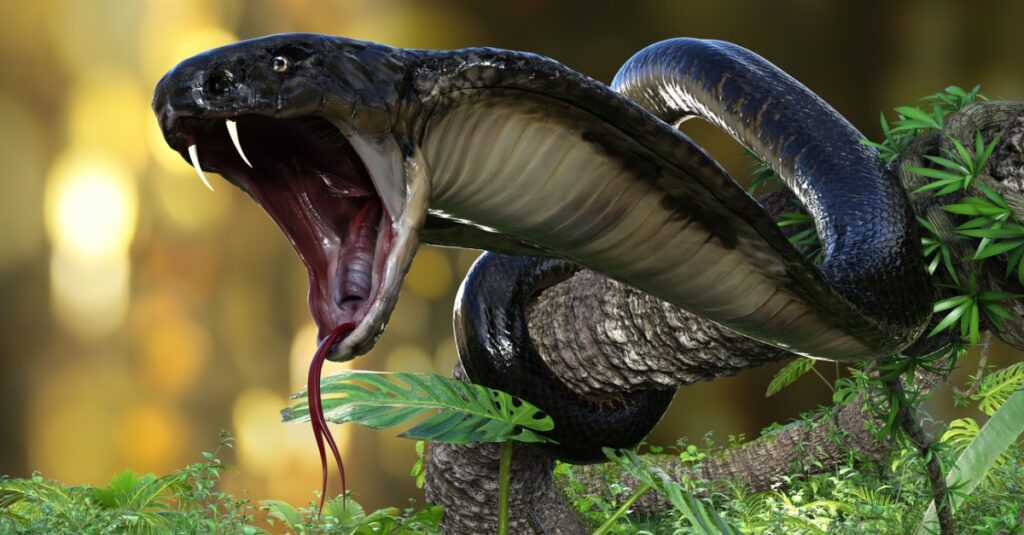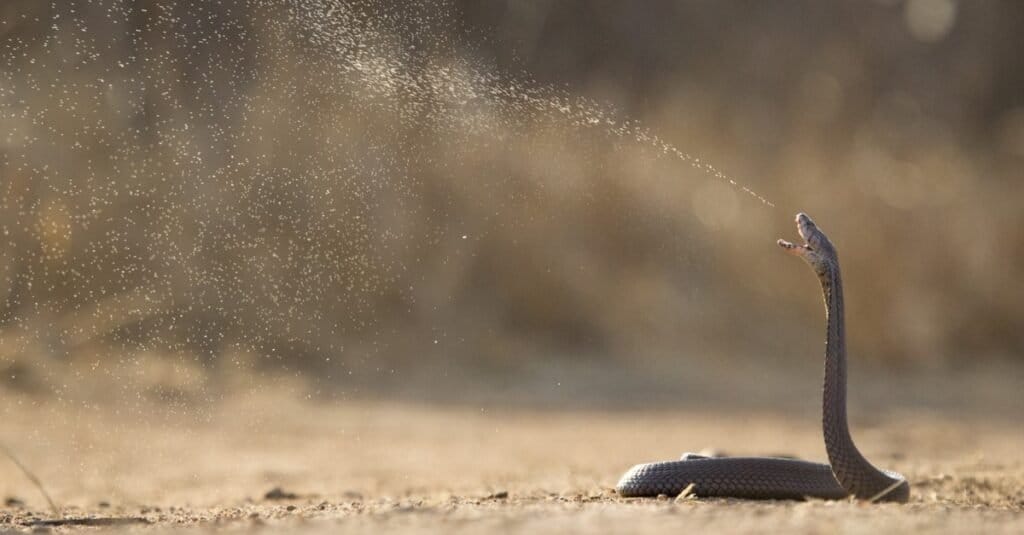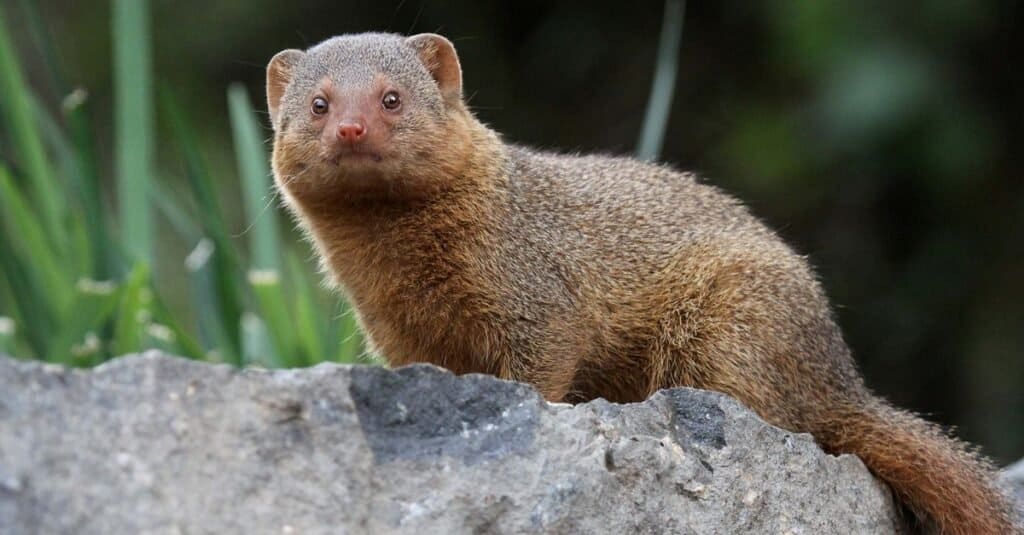Cobras are famous for being highly venomous, but they’re more than just deadly. They’re elapid snakes which means their fangs stay erect instead of folding up into the roof of the mouth when the snake isn’t using them. What are some other incredible cobra facts? Cobras live in Southeast Asia, Indonesia, Africa, India, and the Middle East. All of them have the characteristic fanned hooded appearance that everyone recognizes.
King cobras are included on this list because some facts about them are amazing. They technically aren’t cobras despite being the most recognizable. They’re close cousins to other cobra species and exhibit some of the same behaviors, and since they share a common name, we thought we’d share our incredible discoveries about these snakes with you as well.

Cobras have extra skin around their necks that they stretch out to form their trademark hood.
©Vova Shevchuk/Shutterstock.com
What are other incredible cobra facts out there? Let’s look at 11 more together.
Discovering 11 Incredible Cobra Facts
Here are 11 incredible cobra facts:
- King Cobras grow up to 12 feet, though the largest was 19 feet long.
- The shells of cobra eggs are flexible.
- Caspian cobra venom may help cure cancer.
- King cobras eat pit vipers and are immune to their venom.
- Spitting cobras can cause blindness.
- Venom from spitting cobras can be breathed in, which causes asthma.
- Wild king cobras eat plastic waste.
- The Indian cobra contributes to massive snakebite death tolls on the Indian subcontinent.
- One king cobra bite can kill an elephant.
- The smallest cobra is the Mozambique spitting cobra at 4 feet in length.
- Mongooses eat cobras.
1. The Largest King Cobra Was HUGE
They’re already the longest venomous snake in the world, coming in at 9-12 feet long, though some nonvenomous pythons are longer than them. The longest king cobra ever came in at almost 19 feet, and it was caught in Malaysia.
King cobras are slender, and despite their length, they only weigh about 15-20 pounds.
2. Cobras Have Flexible Eggs
Eggs of snakes are famous for being leathery and flexible. The eggs of a Chinese cobra were studied closely and showed that the keratin that typically makes up avian eggshells is also present in snake eggs. However, the keratin fibers of flexible snake eggs are more scattered than other animal eggshells.
Collagen also plays a role in the flexibility of cobra eggs. These eggs are flexible to protect against damage when dropped into a burrow and to avoid abrasions when dirt rubs against them.
3. Caspian Cobra Venom May Cure Cancer
Studies into snake venom’s effects on cancer cells are ongoing, and cobras have been put in the spotlight. It’s been shown that a Caspian cobra’s venom will kill cancer cells while leaving noncancerous cells alone.
This development could lead to a frontline treatment that can be used in the fight against cancer, which is the top cause of human fatalities in the United States.
4. King Cobras Eat Pit Vipers

King cobras eat pit vipers and other venomous snakes.
©iStock.com/mrjo2405
It has been observed that king cobras eat pit vipers. It’s well known that king cobras dine on other snakes, but the fact that they can eat highly venomous serpents is startling. They are capable of consuming 10-foot snakes, so they aren’t just looking for juveniles.
King cobras eating snakes accounts for almost 1/3 of their total food consumption. They are impervious to the venom of other animals, so it doesn’t matter if the pit viper or other snake they’re trying to eat lands a bite.
5. Spitting Cobras Cause Blindness

The venom of spitting cobras can cause blindness.
©Eugene Troskie/Shutterstock.com
If a spitting cobra’s venom gets into your eyes, it can cause blindness. In a study done on 9 people who were victims of venom being spat into their eyes, 2 were rendered permanently blind while all 9 had symptoms.
6. Airborne Spitting Cobra Venom Particles Causing Asthma
Snake handlers were studied to see if a spitting cobra’s venom was causing asthmatic symptoms. They were observed while they inhaled an aerosol made of snake venom, and they developed asthma symptoms.
One of the participants appears to have been exposed to the toxins of 9 different types of snakes by inhaling their venom. The idea that snake venom is dangerous because it becomes somewhat airborne is a new discovery.
7. Wild King Cobras Eat Plastic Waste
Plastic waste sometimes smells like meat which leads to snakes consuming it. The loss of natural habitat has led to snakes living in polluted areas where this situation commonly occurs. One observed snake ended up dying from ingesting plastic.
8. The Indian Cobra Contributes to Massive Death Tolls in India

Indian cobras kill more than 15,000 people per year.
©RealityImages/Shutterstock.com
About 6.4% of people bitten by this snake end up dying, and it accounts for 12% of all snakebites in India. It is considered one of the “Big 4” in India that helps contribute to more than 50,000 deaths every year.
There are a lot of venomous snakes in India, and there is a lot of opportunity for human and snake interactions due to the climates found in India. Every year, the Indian cobra alone kills over 15,000 people on the Indian subcontinent.
9. Whole Elephants Can Die Over King Cobra Bites
Eleven humans or one elephant can be killed by the venom in one king cobra bite. It isn’t that the venom of these snakes is especially different; it’s that they deliver a whopping dose with each envenomation.
It takes about 1 mg of venom to kill a live mouse, and king cobras deliver up to 500 mg with one successful strike.
10. Mozambique Spitting Cobras Are the Smallest Cobra

The Mozambique spitting cobra can shoot venom up to 10 feet.
©Stu Porter/Shutterstock.com
This snake averages about 4 feet long which makes it the smallest cobra on the planet. That doesn’t stop it from spitting its venom up to 10 feet if necessary.
If cornered, they are aggressive and will raise two-thirds of their body off the ground before spitting. Spitting cobras are purposefully aiming for the eyes so they can hinder the approaching threat.
11. Mongooses Eat Cobras

Mongooses are noted for their audacious attacks on venomous snakes, such as king cobras.
©steve bushman/Shutterstock.com
They’re quicker than a cobra, and a mongoose only needs to land one bite to take the snake down. They’re also not affected by cobra venom. They tolerate it in much the same way as the North American opossum.
The photo featured at the top of this post is © Eugene Troskie/Shutterstock.com
Discover the "Monster" Snake 5X Bigger than an Anaconda
Every day A-Z Animals sends out some of the most incredible facts in the world from our free newsletter. Want to discover the 10 most beautiful snakes in the world, a "snake island" where you're never more than 3 feet from danger, or a "monster" snake 5X larger than an anaconda? Then sign up right now and you'll start receiving our daily newsletter absolutely free.
Thank you for reading! Have some feedback for us? Contact the AZ Animals editorial team.






